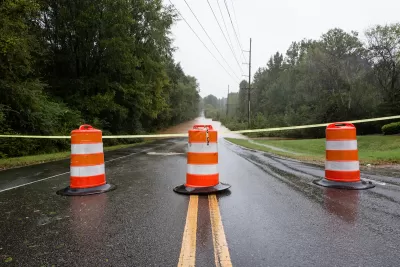The tool will allow local planners to evaluate impacts of flooding and prioritize projects with the biggest return on investment.

The tool will allow local planners to evaluate impacts of flooding and prioritize projects with the biggest return on investment.
The North Carolina Department of Environmental Quality (DEQ) is developing a new online tool to help inform future flood planning. The “Flood Resiliency Blueprint” will compile research and data about flooding in the state to provide a framework that local officials can use to guide adaptation and mitigation efforts, says a Governing article by Adam Wagner.
In the face of more frequent, intensifying rain events, the goal is to help local governments more easily identify projects that will have measurable outcomes for their communities so they can take swift action. “Officials will be able to home in on the area where the project is proposed and see exactly how many people, homes, roads and community assets the project will protect,” Wagner writes.
The tool is designed so anyone can use it and will use two-dimensional modeling that allows planners to evaluate the impacts of flooding from rivers and heavy rain events. “To make sure we know what the projects with the best return on investment are, we are developing a standardized methodology to analyze flood risk and prioritize flood mitigation strategies across the state. We are ensuring that decision makers at all levels will be able to identify and select which strategies are most impactful where they are,” DEQ Secretary Elizabeth Biser told Governing.
The North Carolina legislature allocated a total of $20 million for the project, which includes developing and building the flood blueprint tool, as well as six river basin-specific action strategies. Another $96 million has been allocated to fund the construction of projects identified in those river-basin planning documents.
Some state legislators expressed concerns that the blueprint would be used by DEQ to tell local governments which actions they can and cannot take. Biser assured them that, apart from how the $96 million is spent, the state will not be the decision-making entity on local projects.
Beta testing for the tool is slated for mid-April and launch is expected in December.
FULL STORY: North Carolina Is Spending Millions on a Flood Blueprint

Planetizen Federal Action Tracker
A weekly monitor of how Trump’s orders and actions are impacting planners and planning in America.

Congressman Proposes Bill to Rename DC Metro “Trump Train”
The Make Autorail Great Again Act would withhold federal funding to the system until the Washington Metropolitan Area Transit Authority (WMATA), rebrands as the Washington Metropolitan Authority for Greater Access (WMAGA).

The Simple Legislative Tool Transforming Vacant Downtowns
In California, Michigan and Georgia, an easy win is bringing dollars — and delight — back to city centers.

The States Losing Rural Delivery Rooms at an Alarming Pace
In some states, as few as 9% of rural hospitals still deliver babies. As a result, rising pre-term births, no adequate pre-term care and "harrowing" close calls are a growing reality.

The Small South Asian Republic Going all in on EVs
Thanks to one simple policy change less than five years ago, 65% of new cars in this Himalayan country are now electric.

DC Backpedals on Bike Lane Protection, Swaps Barriers for Paint
Citing aesthetic concerns, the city is removing the concrete barriers and flexposts that once separated Arizona Avenue cyclists from motor vehicles.
Urban Design for Planners 1: Software Tools
This six-course series explores essential urban design concepts using open source software and equips planners with the tools they need to participate fully in the urban design process.
Planning for Universal Design
Learn the tools for implementing Universal Design in planning regulations.
Smith Gee Studio
City of Charlotte
City of Camden Redevelopment Agency
City of Astoria
Transportation Research & Education Center (TREC) at Portland State University
US High Speed Rail Association
City of Camden Redevelopment Agency
Municipality of Princeton (NJ)





























